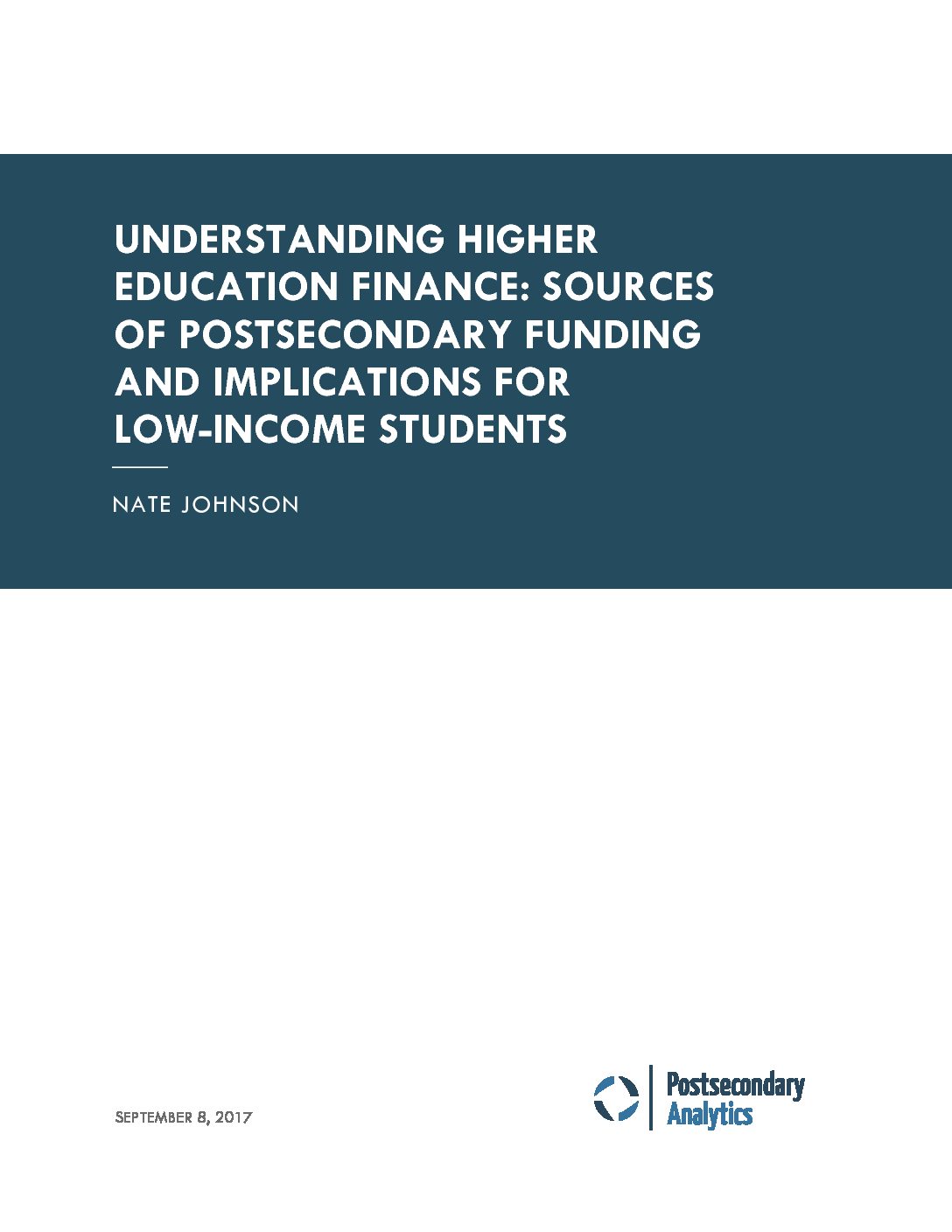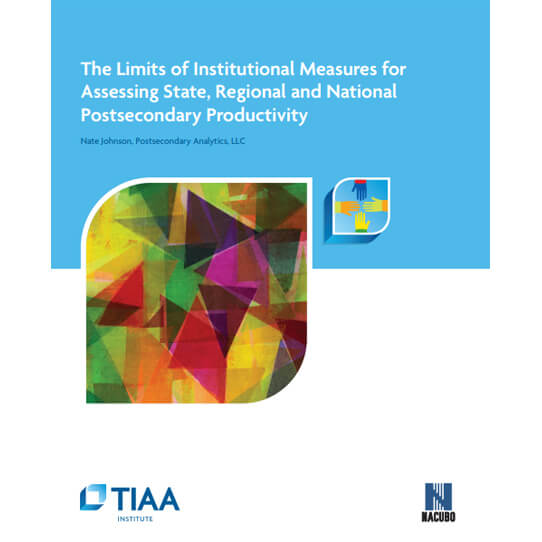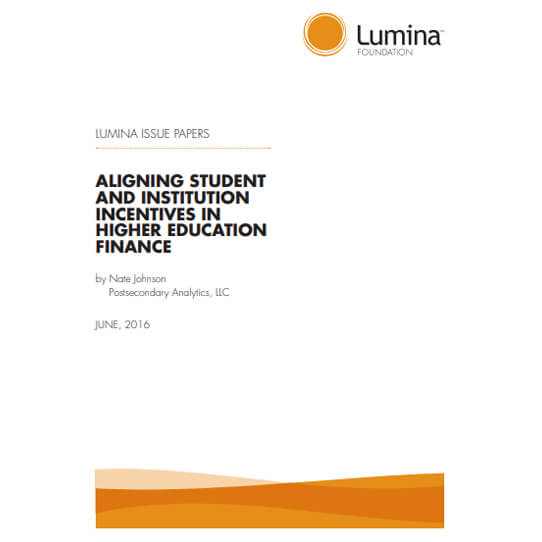Research and analysis for states, systems and institutions with students’ interests at heart.
Affirmative Action Ruling Treats Higher Education as a Prize to be Won
Here are a couple of thoughts to add to the mix as legal experts and university administrators work out the meaning of today’s unsurprising ruling on affirmative action in elite college admissions. First, the framing of higher education as a competitive prize to be won, which is shared by many parties on both sides of
Accountability Illusions, Simpson’s Paradox and the Bottom Line
In the latest IPEDS graduation rate data (2021 graduates), Pennsylvania’s two-year (primarily associate degree) public institutions ranked 14th among the 50 states, and its four-year (primarily bachelor’s) institutions ranked 37th in the percent of students completing within 150% of the normal time. (I know and agree with many of the arguments about IPEDS grad rates,
The Florida Lottery and Bright Futures Reverse Robin Hood
I was recently engaged to help Orlando Sentinel reporters Leslie Postal and Anne Martin with data analysis for their extensively-researched article “How Bright Futures Favors Florida’s Wealthier Families.” If you want to explore the data in your own community, here is a set of maps and charts that let you see the distribution of lottery
State Postsecondary Equity Funding Measures
Collectively, the measures here are intended to reflect differences in levels of postsecondary investment from the perspective of students in different demographic groups. While no single measure is perfect, each one attempts to capture an important dimension of postsecondary funding. Most of the measures reflect differences in the types of institutions students attend. In these
Working Paper Estimates Impact of Cal Grant Equity Framework on Enrollments, Completions, Income and Tax Revenue
The “Cal Grant Equity Framework” (the “Equity Framework”) aims to cover more of the entire cost of attendance, including tuition and fees and other expenses such as textbooks, housing, and meals. It consolidates existing programs into two, makes benefits more predictable, and moves GPA requirements closer to alignment with the federal standard for Pell grants.
Distribution of Student Debt and Potential Forgiveness
Using data from the U.S. Census Survey of Income and Program Participation (SIPP), this interactive Tableau data story shows how education debt is distributed by race/ethnicity, education level, income and state, subject to the sampling and design limitations of the survey. It also allows users to model different levels of theoretical debt forgiveness to see
Variations in Postsecondary Institution Spending on Instruction and Student Services by Race/Ethnicity and Gender
My working analysis of institutional finance finds that, overall, U.S. postsecondary institutions spent $11,925 on instruction and student services in FY 2020 for every student enrolled in fall 2020. But different subgroups of students attended institutions with different levels of spending. Black or African American students attended institutions that spent $9,768 per student, or about

Understanding Higher Education Finance
Every year, the United States invests more than $800 billion in postsecondary education, if the budgets of postsecondary institutions and students and the cost of federal and state tax credits are all included. Yet the total extent of the investment is rarely discussed. This report, produced with support from the Bill & Melinda Gates Foundation,

When Is Higher Education Productivity an Institutional Issue and When Is It Systemic?
In a paper published by TIAA Institute and NACUBO as part of a series examining higher education productivity, Nate Johnson argues that much of higher education’s output is a function of its systemic structure and composition, rather than simply the sum of its institutional parts. Historically, gains in total outputs have happened both by adding

Lumina Foundation Paper Examines Institutional and Student Incentives in Higher Education Business Model
In a paper commissioned by Lumina Foundation for a series on outcomes-based funding, Nate Johnson examines the role of institutional and student incentives in higher education finance. Nationally, the primary driver of revenue for colleges and institutions is the credit hour, a measure of short-term student enrollment. Credit hours produce revenue for institutions primarily through the
Analyzing the Relationship Between Higher Education and Jobs at CAPSEE by Nate Johnson
Analyzing the Relationship Between Higher Education and Jobs at CAPSEE This year’s Center for Analysis of Postsecondary Education and Employment (CAPSEE) Convention featured four plenary and 12 breakout sections all centered on the idea of The Value of Education—And How to Further Strengthen It. Specifically, we came together to review emerging research on the relationship
Thoughts on Quebec’s Pre-University System by Nate Johnson
Quebec’s system of “General and Vocational Colleges” or “CEGEPs” in French, combine what in other places in the U.S. and Canada would be the senior year of high school and the first year of college into a two year pre-university program that is free to students and covers most of the general education and major prerequisite courses that students need.
Three Strategies that Moved the Needle in Kentucky by Nate Johnson
With its commitment to higher education reform and measurable, systemic goals that have proven attainable, Kentucky has become a model for other states. Though there are many reasons for the success, three key factors stand out: strong leadership for whom education is a top priority, clearly defined goals and smart financial aid programs designed to
Presentation on Results of Survey on Uses of Unit Cost Analysis on Campus
This survey study, funded through a grant from the Japan Society for the Promotion of Science (the Basic Research B category of the Grants-in-Aid for Scientific Research, Project Code: 25285236), is part of a multinational research project examining how unit instructional cost expenditure measures are defined, calculated, and used in campus-level decision making across higher
New Research Brief Describes Different Tuition Structures at Flagship Universities and Community Colleges
A new research brief finds that “linear” tuition is most common at public community colleges, while flat rate tuition prevails at state flagship universities. The complete research brief is available here.
AIR Forum 1 – Full-Time vs. On-Time: Results from a Survey of Student Course Load Intensity Commissioned by Complete College America
Results from the survey of course enrollment patterns are summarized in an AIR Forum presentation here. The original Complete College America brief and related materias are available on the CCA website. The associated database may be accessed here.

Initial Evaluation of Indiana Financial Aid Reforms Finds Positive Effect of Incentives to Complete 30 Credit Hours
The Indiana Commission for Higher Education hired Postsecondary Analytics to evaluate the effect of reforms to the state’s primary financial aid programs. The reforms, implemented in 2013, required students to complete 30 credit hours per year to receive the maximum award, with reduced aid levels for students who completed 24 hours. Using a quasi-experimental “difference-in-differences” approach,
Three Policies to Reduce Time to Degree
In “Three Policies to Reduce Time to Degree” principal of Postsecondary Analytics, LLC, and senior consultant for HCM Strategists LLC, Nate Johnson suggests several strategies to address lagging college completion rates.
Nikkei Business Daily showcases Postsecondary Analytics and Ken Hoyt’s Optimizing Academic Balance (OAB)
New Trend in Higher Education Marketing (6) “Utilizing For-profit Consulting Firms to Improve Institutional Management” In the US, there are many consulting firms that provide universities with institutional research services. Mr. Takeshi Yanagiura is one such consultant. As one of a few Japanese professionals in institutional research in the US, he has participated in many
New York Times Op-Ed: Stop Penalizing Poor Students
Nate Johnson of Postsecondary Analytics, Kristin Conklin of HCM Strategists, and Sandy Baum of the George Washington University and Urban Institute argue that the design of the Pell grant program may further disadvantage some low-income students. Read the op-ed here.
Affirmative Action Ruling Treats Higher Education as a Prize to be Won
Here are a couple of thoughts to add to the mix as legal experts and university administrators work out the meaning of today’s unsurprising ruling on affirmative action in elite college admissions. First, the framing of higher education as a competitive prize to be won, which is shared by many parties on both sides of the issue, probably made the ruling more likely and will also get in the way of efforts to shape admissions
Accountability Illusions, Simpson’s Paradox and the Bottom Line
In the latest IPEDS graduation rate data (2021 graduates), Pennsylvania’s two-year (primarily associate degree) public institutions ranked 14th among the 50 states, and its four-year (primarily bachelor’s) institutions ranked 37th in the percent of students completing within 150% of the normal time. (I know and agree with many of the arguments about IPEDS grad rates, but this isn’t really about that). By contrast, Florida’s primarily associate institutions collectively ranked 5th, and its primarily bachelor’s institutions
The Florida Lottery and Bright Futures Reverse Robin Hood
I was recently engaged to help Orlando Sentinel reporters Leslie Postal and Anne Martin with data analysis for their extensively-researched article “How Bright Futures Favors Florida’s Wealthier Families.” If you want to explore the data in your own community, here is a set of maps and charts that let you see the distribution of lottery revenue and Bright Futures awards in most of the state’s major metro areas. Scroll over any zip code for more
State Postsecondary Equity Funding Measures
Collectively, the measures here are intended to reflect differences in levels of postsecondary investment from the perspective of students in different demographic groups. While no single measure is perfect, each one attempts to capture an important dimension of postsecondary funding. Most of the measures reflect differences in the types of institutions students attend. In these cases institutional averages are weighted by student enrollment by demographic group, then rolled up at the state or national level.
Working Paper Estimates Impact of Cal Grant Equity Framework on Enrollments, Completions, Income and Tax Revenue
The “Cal Grant Equity Framework” (the “Equity Framework”) aims to cover more of the entire cost of attendance, including tuition and fees and other expenses such as textbooks, housing, and meals. It consolidates existing programs into two, makes benefits more predictable, and moves GPA requirements closer to alignment with the federal standard for Pell grants. The California Student Aid Commission (CSAC) estimates the annual cost of the program to be $315 million and that it
Distribution of Student Debt and Potential Forgiveness
Using data from the U.S. Census Survey of Income and Program Participation (SIPP), this interactive Tableau data story shows how education debt is distributed by race/ethnicity, education level, income and state, subject to the sampling and design limitations of the survey. It also allows users to model different levels of theoretical debt forgiveness to see how the benefits would be distributed and how much debt would remain. Click through the slides at the top to
Variations in Postsecondary Institution Spending on Instruction and Student Services by Race/Ethnicity and Gender
My working analysis of institutional finance finds that, overall, U.S. postsecondary institutions spent $11,925 on instruction and student services in FY 2020 for every student enrolled in fall 2020. But different subgroups of students attended institutions with different levels of spending. Black or African American students attended institutions that spent $9,768 per student, or about 18% less than average. Hispanic or Latino students attended institutions that spent $9,605, or 19% less than average. Nonresident alien

Understanding Higher Education Finance
Every year, the United States invests more than $800 billion in postsecondary education, if the budgets of postsecondary institutions and students and the cost of federal and state tax credits are all included. Yet the total extent of the investment is rarely discussed. This report, produced with support from the Bill & Melinda Gates Foundation, covers the full range of funding sources our postsecondary system depends upon, from state appropriations to institutions to support students

When Is Higher Education Productivity an Institutional Issue and When Is It Systemic?
In a paper published by TIAA Institute and NACUBO as part of a series examining higher education productivity, Nate Johnson argues that much of higher education’s output is a function of its systemic structure and composition, rather than simply the sum of its institutional parts. Historically, gains in total outputs have happened both by adding new institutions and by growing existing ones, while some of the biggest gains in efficiency (or its conceptual cousin, productivity)

Lumina Foundation Paper Examines Institutional and Student Incentives in Higher Education Business Model
In a paper commissioned by Lumina Foundation for a series on outcomes-based funding, Nate Johnson examines the role of institutional and student incentives in higher education finance. Nationally, the primary driver of revenue for colleges and institutions is the credit hour, a measure of short-term student enrollment. Credit hours produce revenue for institutions primarily through the tuition transaction (student payment, with or without financial aid offsets) and in some cases by determining the amount of state
Analyzing the Relationship Between Higher Education and Jobs at CAPSEE by Nate Johnson
Analyzing the Relationship Between Higher Education and Jobs at CAPSEE This year’s Center for Analysis of Postsecondary Education and Employment (CAPSEE) Convention featured four plenary and 12 breakout sections all centered on the idea of The Value of Education—And How to Further Strengthen It. Specifically, we came together to review emerging research on the relationship between higher education and jobs. There has always been tension between higher education’s role in vocational training and its broader
Thoughts on Quebec’s Pre-University System by Nate Johnson
Quebec’s system of “General and Vocational Colleges” or “CEGEPs” in French, combine what in other places in the U.S. and Canada would be the senior year of high school and the first year of college into a two year pre-university program that is free to students and covers most of the general education and major prerequisite courses that students need.
Three Strategies that Moved the Needle in Kentucky by Nate Johnson
With its commitment to higher education reform and measurable, systemic goals that have proven attainable, Kentucky has become a model for other states. Though there are many reasons for the success, three key factors stand out: strong leadership for whom education is a top priority, clearly defined goals and smart financial aid programs designed to educate and engage students and their families. By applying these factors on a consistent basis, other states could follow suit
Presentation on Results of Survey on Uses of Unit Cost Analysis on Campus
This survey study, funded through a grant from the Japan Society for the Promotion of Science (the Basic Research B category of the Grants-in-Aid for Scientific Research, Project Code: 25285236), is part of a multinational research project examining how unit instructional cost expenditure measures are defined, calculated, and used in campus-level decision making across higher education institutions in the United States. In order to help answer those questions, we developed and distributed an institutional survey, and
New Research Brief Describes Different Tuition Structures at Flagship Universities and Community Colleges
A new research brief finds that “linear” tuition is most common at public community colleges, while flat rate tuition prevails at state flagship universities. The complete research brief is available here.
AIR Forum 1 – Full-Time vs. On-Time: Results from a Survey of Student Course Load Intensity Commissioned by Complete College America
Results from the survey of course enrollment patterns are summarized in an AIR Forum presentation here. The original Complete College America brief and related materias are available on the CCA website. The associated database may be accessed here.

Initial Evaluation of Indiana Financial Aid Reforms Finds Positive Effect of Incentives to Complete 30 Credit Hours
The Indiana Commission for Higher Education hired Postsecondary Analytics to evaluate the effect of reforms to the state’s primary financial aid programs. The reforms, implemented in 2013, required students to complete 30 credit hours per year to receive the maximum award, with reduced aid levels for students who completed 24 hours. Using a quasi-experimental “difference-in-differences” approach, we found significant increases in credit hours attempted and completed. Students affected by the new policy increased their course loads
Three Policies to Reduce Time to Degree
In “Three Policies to Reduce Time to Degree” principal of Postsecondary Analytics, LLC, and senior consultant for HCM Strategists LLC, Nate Johnson suggests several strategies to address lagging college completion rates.
Nikkei Business Daily showcases Postsecondary Analytics and Ken Hoyt’s Optimizing Academic Balance (OAB)
New Trend in Higher Education Marketing (6) “Utilizing For-profit Consulting Firms to Improve Institutional Management” In the US, there are many consulting firms that provide universities with institutional research services. Mr. Takeshi Yanagiura is one such consultant. As one of a few Japanese professionals in institutional research in the US, he has participated in many projects in a variety of higher education settings such as states, institutions, and non-profit organizations. Mr. Yanagiura currently serves as
New York Times Op-Ed: Stop Penalizing Poor Students
Nate Johnson of Postsecondary Analytics, Kristin Conklin of HCM Strategists, and Sandy Baum of the George Washington University and Urban Institute argue that the design of the Pell grant program may further disadvantage some low-income students. Read the op-ed here.
